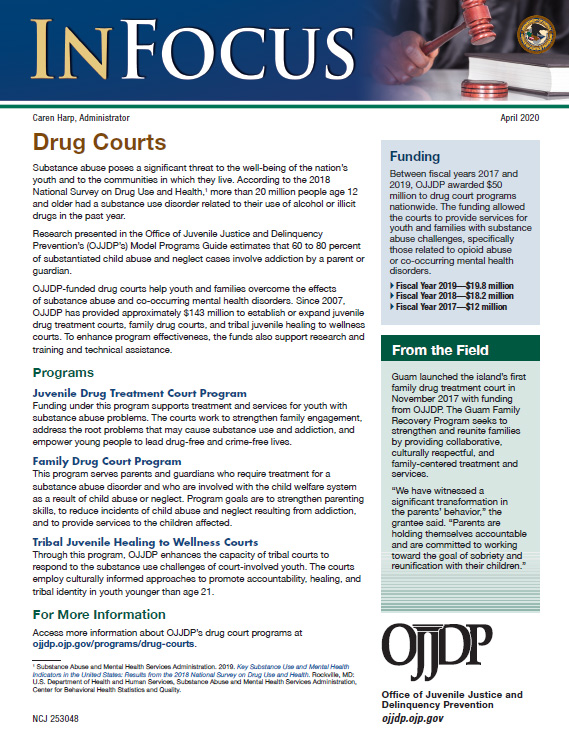 In 2018, more than 67,300 people died from a drug overdose in the United States. Opioids were involved in approximately 70 percent of these deaths. In addition to its lethal consequences, substance use disorders can disrupt families, result in job loss, and lead to drug-related crime. Addiction depletes social and economic resources and burdens the justice and child welfare systems.
In 2018, more than 67,300 people died from a drug overdose in the United States. Opioids were involved in approximately 70 percent of these deaths. In addition to its lethal consequences, substance use disorders can disrupt families, result in job loss, and lead to drug-related crime. Addiction depletes social and economic resources and burdens the justice and child welfare systems.
The first drug court opened its doors more than 30 years ago to offer substance abuse treatment in the context of regular court-ordered appearances, drug testing, and judicial monitoring of treatment participation. Effective drug courts bring together treatment providers, child welfare services, mental health agencies, and other community partners to work as a team in promoting the recovery process.
According to the National Association of Drug Court Professionals (NADCP), today there are approximately 4,000 drug court programs in every state, 4 territories, and more than 20 countries. In May of each year, NADCP coordinates National Drug Court Month, a campaign to raise awareness about the central role drug courts play in empowering youth and families to lead drug- and crime-free lives.
 OJJDP's recently released Drug Courts fact sheet describes how OJJDP-supported drug courts are addressing substance abuse and its effect on youth and families.
OJJDP's recently released Drug Courts fact sheet describes how OJJDP-supported drug courts are addressing substance abuse and its effect on youth and families.Between fiscal years 2017 and 2019, OJJDP awarded $50 million to drug courts across the country through the following programs:
- Juvenile Drug Treatment Court Program. Juvenile drug courts are dockets within juvenile courts for cases involving youth with substance use disorders who need specialized treatment. These courts allow for intensive judicial supervision of youth that would not ordinarily be available in the traditional juvenile court process.
- Family Drug Court Program. Family drug courts serve parents who require substance abuse treatment and who are involved with the child welfare system because of child abuse, neglect, or other parenting issues. These courts work to improve the health, safety, and welfare of children and to support parents in their recovery through judicial oversight and access to individualized treatment services. The goal is to promote family reunification and stability.
- Tribal Juvenile Healing to Wellness Courts. As part of the Department of Justice’s Coordinated Tribal Assistance Solicitation, this initiative helps tribal courts respond to substance abuse in youth younger than age 21. Tribal juvenile healing to wellness courts increase community safety by holding youth accountable for delinquent behaviors while promoting recovery within a culturally supportive framework.
- Drug Treatment Courts Training and Technical Assistance Program. This initiative helps drug treatment courts increase their effectiveness through research-based services; consistent and efficient case planning, monitoring, and supervision procedures; and the use of performance measures to improve drug court case processing and service delivery.
Resources:
Read an Office of Justice Programs blog on how OJJDP-supported drug courts are adapting their practices during the COVID-19 epidemic to continue serving youth and families.
This issue of OJJDP News @ a Glance features an article about how OJJDP funding has helped the Rankin County, MS, Juvenile Drug Treatment Court improve data collection, use evidence-based treatment models, and more fully engage parents in the recovery process.
Read about how an OJJDP grant enabled the Judiciary of Guam to launch the island’s first family drug treatment court.
The OJJDP Model Programs Guide provides evaluations of juvenile and family drug court programs and a review of research on drug courts.
Access more information about OJJDP’s drug court programs on the Office’s website.
